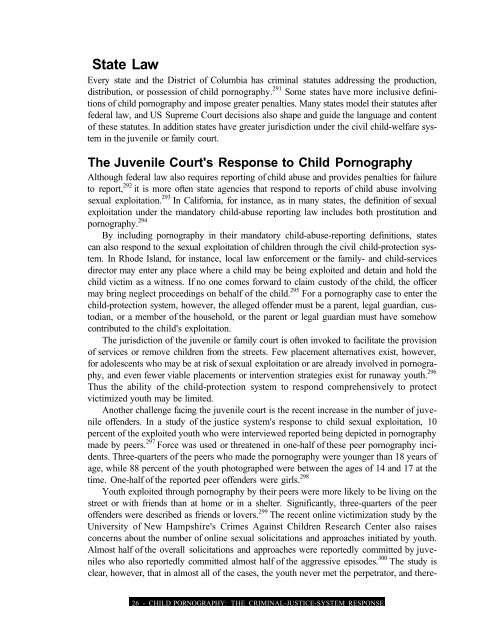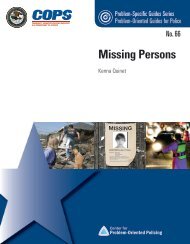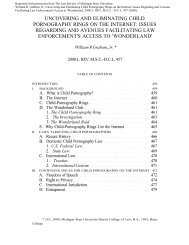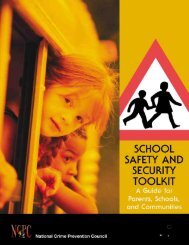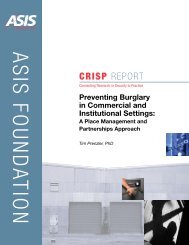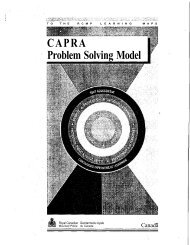Child Pornography: - Center for Problem-Oriented Policing
Child Pornography: - Center for Problem-Oriented Policing
Child Pornography: - Center for Problem-Oriented Policing
Create successful ePaper yourself
Turn your PDF publications into a flip-book with our unique Google optimized e-Paper software.
State Law<br />
Every state and the District of Columbia has criminal statutes addressing the production,<br />
distribution, or possession of child pornography. 291 Some states have more inclusive definitions<br />
of child pornography and impose greater penalties. Many states model their statutes after<br />
federal law, and US Supreme Court decisions also shape and guide the language and content<br />
of these statutes. In addition states have greater jurisdiction under the civil child-welfare system<br />
in the juvenile or family court.<br />
The Juvenile Court's Response to <strong>Child</strong> <strong>Pornography</strong><br />
Although federal law also requires reporting of child abuse and provides penalties <strong>for</strong> failure<br />
to report, 292 it is more often state agencies that respond to reports of child abuse involving<br />
sexual exploitation. 293 In Cali<strong>for</strong>nia, <strong>for</strong> instance, as in many states, the definition of sexual<br />
exploitation under the mandatory child-abuse reporting law includes both prostitution and<br />
pornography. 294<br />
By including pornography in their mandatory child-abuse-reporting definitions, states<br />
can also respond to the sexual exploitation of children through the civil child-protection system.<br />
In Rhode Island, <strong>for</strong> instance, local law en<strong>for</strong>cement or the family- and child-services<br />
director may enter any place where a child may be being exploited and detain and hold the<br />
child victim as a witness. If no one comes <strong>for</strong>ward to claim custody of the child, the officer<br />
may bring neglect proceedings on behalf of the child. 295 For a pornography case to enter the<br />
child-protection system, however, the alleged offender must be a parent, legal guardian, custodian,<br />
or a member of the household, or the parent or legal guardian must have somehow<br />
contributed to the child's exploitation.<br />
The jurisdiction of the juvenile or family court is often invoked to facilitate the provision<br />
of services or remove children from the streets. Few placement alternatives exist, however,<br />
<strong>for</strong> adolescents who may be at risk of sexual exploitation or are already involved in pornography,<br />
and even fewer viable placements or intervention strategies exist <strong>for</strong> runaway youth. 296<br />
Thus the ability of the child-protection system to respond comprehensively to protect<br />
victimized youth may be limited.<br />
Another challenge facing the juvenile court is the recent increase in the number of juvenile<br />
offenders. In a study of the justice system's response to child sexual exploitation, 10<br />
percent of the exploited youth who were interviewed reported being depicted in pornography<br />
made by peers. 297 Force was used or threatened in one-half of these peer pornography incidents.<br />
Three-quarters of the peers who made the pornography were younger than 18 years of<br />
age, while 88 percent of the youth photographed were between the ages of 14 and 17 at the<br />
time. One-half of the reported peer offenders were girls. 298<br />
Youth exploited through pornography by their peers were more likely to be living on the<br />
street or with friends than at home or in a shelter. Significantly, three-quarters of the peer<br />
offenders were described as friends or lovers. 299 The recent online victimization study by the<br />
University of New Hampshire's Crimes Against <strong>Child</strong>ren Research <strong>Center</strong> also raises<br />
concerns about the number of online sexual solicitations and approaches initiated by youth.<br />
Almost half of the overall solicitations and approaches were reportedly committed by juveniles<br />
who also reportedly committed almost half of the aggressive episodes. 300 The study is<br />
clear, however, that in almost all of the cases, the youth never met the perpetrator, and there-<br />
26 - CHILD PORNOGRAPHY: THE CRIMINAL-JUSTICE-SYSTEM RESPONSE


